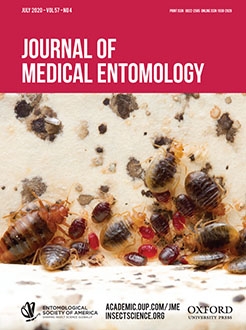The microbiota of mites is closely related to their growth, development, and pathogenicity. Therefore, it is necessary to study the bacteria in mites. Here, for the first time, based on 16s rRNA V3-V4 region, the microbiota of 45 samples of nine species in six families of medically important mites were analyzed using Illumina MiSeq sequencing technique.The results showed that, at the phylum level, Proteobacteria (56.20–86.40%) were the dominant, followed by Firmicutes (6.41–19.43%), Bacteroidetes (5.56–13.38%) and Actinobacteria (1.93–28.07%). But at the genera the microbiota of mites are different, showing four characteristics: 1) The microbiota is related to the parasitic host. Demodex folliculorum (Acariforms: Demodicidae) and D. brevis (Acariforms: Demodicidae), both parasitizing humans, showed similar microbial composition, as did D. canis (Acariforms: Demodicidae) and Sarcoptes scabiei canis (Acariforms: Sarcoptidae) parasitizing dogs, but D. caprae (Acariforms: Demodicidae) parasitizing sheep showed unique microbial community; 2) The microbiota is related to mite's species. Dermatophagoides farinae and Cheyletus malaccensis (Acariforms: Cheyletidae), both collecting from flour, show respective microbial composition; 3) The microbiota is related to the life stage. There were differences in microbiota between adults and larvae of D. farinae, but no differences observed in Psoroptes cuniculi (Acariforms: Psoroptidae); and 4) The microbiota is related to the blood-feeding state.The microbiota of blood-fed Ornithonyssus bacoti (Parasitiformes: Macronyssidae) adults was significantly higher than that of unfed adults. This indicates that the microbiota of mites is affected by mite species, parasitic host, growth stage and habitat.Therefore, understanding these influencing factors will have a very important guiding significance for the prevention and control of mite-borne diseases.
How to translate text using browser tools
26 March 2020
Study on the Relationship Between Microbial Composition and Living Environment in Important Medical Mites Based on Illumina MiSeq Sequencing Technology
Yijie Guo,
Ruiling Wang,
Yae Zhao,
Dongling Niu,
Xiaojuan Gong,
Li Hu
ACCESS THE FULL ARTICLE
It is not available for individual sale.
This article is only available to subscribers.
It is not available for individual sale.
It is not available for individual sale.

Journal of Medical Entomology
Vol. 57 • No. 4
July 2020
Vol. 57 • No. 4
July 2020
Illumina MiSeq sequencing
living environment
microbiota
mite




